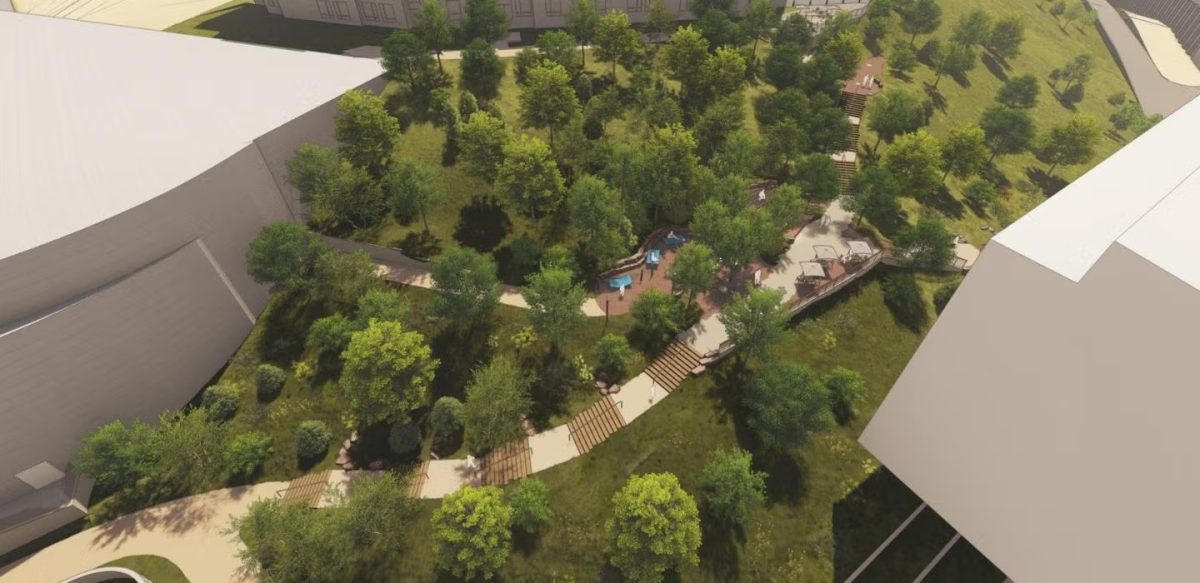One of the only ways to get from lower to upper campus is the steep Cardiac Hill on DeSoto Street. On Sept. 24, Pitt’s Property and Facilities Committee approved a plan to build a new path called Panther Overlook.
Panther Overlook, which is expected to be completed in the spring of 2026, will connect the upper and lower campus and create a space for Pitt’s community to reconnect with nature.
“We hope the Overlook will be a tranquil place where students, staff and visitors can stroll after their day’s work is done, reconnect with nature and see, hear and feel nothing of the bustle of Oakland,” Mark Barnett, senior project manager of Panther Overlook, said.
The project includes three components — a stormwater collection system from the hillside to the Mazeroski Field, pathways, hangout spaces and hillside reforestation.
Barnett said the path “connects upper and lower campus both physically and experientially.”
“Panther Overlook creates a special outdoor space that fosters community while honoring our commitment to sustainability,” Barnett said.
Not only will Panther Overlook make it easier to get from lower to upper campus, but its environmentally friendly features contribute to Pitt’s goal of carbon neutrality by 2037.
“The stormwater collection system is important because it will allow us to repurpose stormwater … saving an estimated four million gallons of water per year,” Barnett said, adding that the water will be used for chilled water plants.
“With a harmonious combination of natural, built and underground infrastructure, Panther Overlook will increase accessibility, tree cover and ecosystems by creating a new, welcoming space for people to gather and connect with nature and each other,” Aurora Sharrard, assistant vice chancellor for sustainability, said.
A key feature of Panther Overlook will be hangout spaces and pathways. Barnett said Panther Overlook will “create a stronger sense of connection and community.”
“The goal is to ensure that the journey up the hill is a cohesive, tangible experience that simplifies how people move from the lower campus through the hillside in a naturalistic, park-like environment,” Barnett said.
The pathway will create a new pedestrian route from O’Hara Street to Allequippa Street, connecting to Panther Run.
“There are also stairs and express elevators under construction that will link Panther Overlook to O’Hara Street by way of the fifth floor entrance of the new Recreation and Wellness Center and its terrace,” Barnett said.
Students who live on upper campus are hopeful for the plan. Heather Jang, a first-year biology major, said she hopes the path makes her commute to lower campus easier.
“It’s hard to walk up that hill,” Jang said, “especially when the escalators in the Petersen Events Center are closed.”
Melina Mazzella, a first-year public health major, said while she doesn’t mind the walk, she’s “worried about winter weather.”
“The commute isn’t too bad, especially with escalators in the Pete,” Mazzella said. “The weather hasn’t been too bad, but with snowy and icy weather coming, I’m wondering how that will affect the hill.”
Mazzella said she is “excited” about the construction of Panther Overlook.
“Although I won’t live on upper campus by the time it’s built, I think it’ll make the commute much easier for future students,” Mazzella said.
Natalee Ristvey, a first-year communications major, also said she is excited about the construction of Panther Overlook.
“I think the path will make the commute between upper and lower campus more scenic,” Ristvey said. “It will definitely make it easier for future students who live in dorms on upper campus.”
Ristvey said that it would be nice to have an “easier way” to get back to her dorm.
“It can be a hassle to get to lower campus, and I don’t like walking back late at night,” Ristvey said. “Building a new path is great news.”


